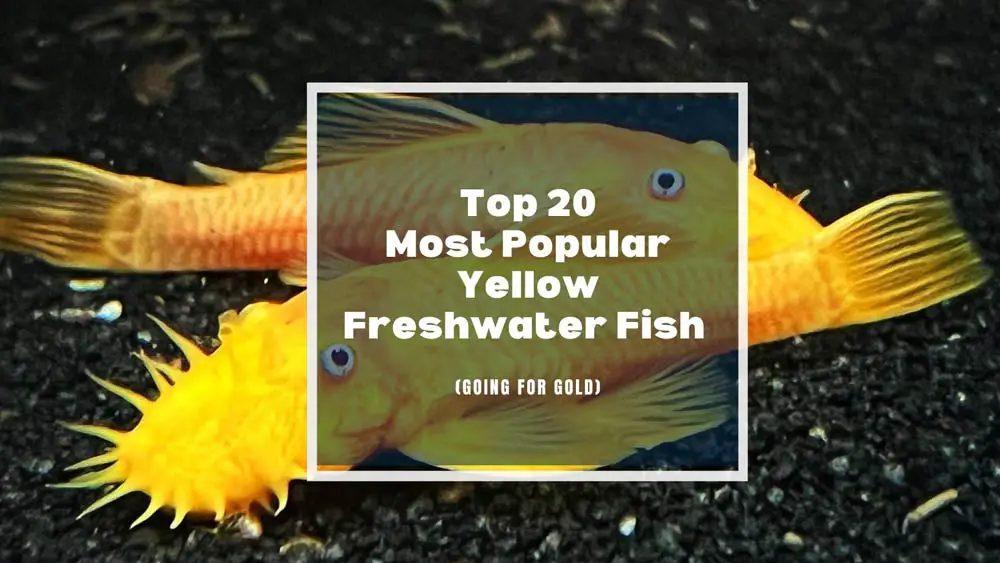Do you have a thing for yellow fish? No, not Charlie Sheen – we’re talking about tropical fish. Yep, it turns out that many different species of yellow tropical fish can be found in aquariums in the world.
So if you’re in the market for a new addition to brighten up your underwater world, why not check out some of these beautiful creatures? From small and slender killifish to brightly-colored cichlids, there’s definitely something for everyone when it comes to yellow aquarium fish.
With so many different types of yellow tropical fish to choose from, it can be a little tricky to decide which one is right for you. Everyone has their own preferences.
But don’t worry – we’re here to help!
That’s why we’ve put together this list of our favorite yellow freshwater fish for your tank. Trust us, no matter what your setup is, you’re sure to find the perfect yellow fish for your freshwater aquarium.
Gold Honey Gourami (Trichogaster chuna)
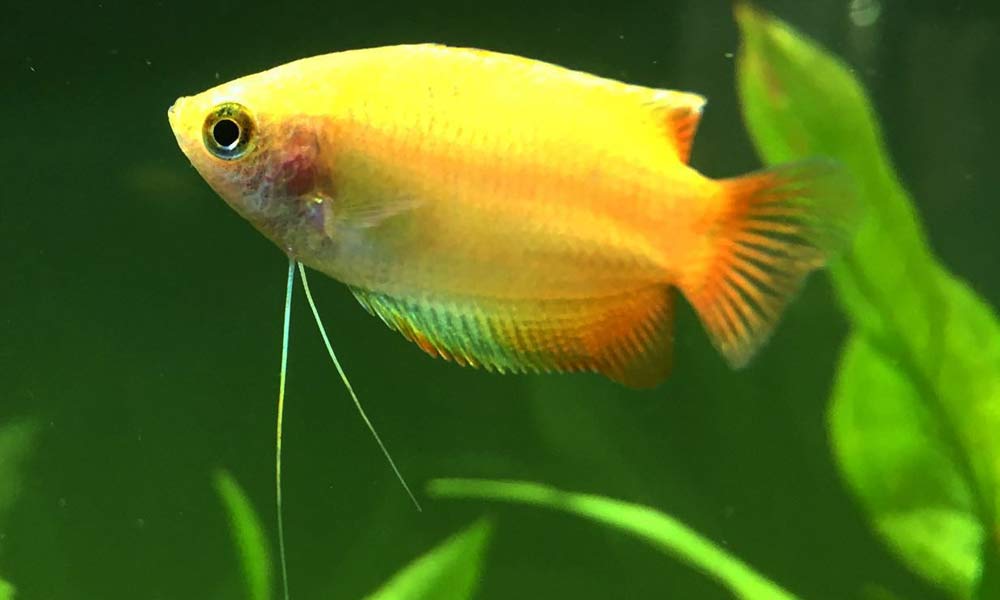
We’re starting off our list of striking yellow fish with the favored peaceful Gold Honey Gourami. This species is an absolutely beautiful centerpiece fish for small tanks.
The gold honey gourami, also known as honey dwarf gourami, is similar to a betta fish but not as aggressive and can easy to get along with a wide range of tank mates.
They take on brightly colored yellow and orange tones all over their body. Males are usually more brightly colored than females, especially when they are ready to breed.
Like betta fish, honey gouramis are bubble nests builders and have a special labyrinth organ that allows them to breathe surface air. These little guys only grow to be about 2.2 inches (5.5cm) long, making them the perfect size for small tanks.
Not to mention, they’re very easy to care for and make great beginner fish. They can even be kept in nano tanks as small as 10 gallons.
| Scientific Name: | Trichogaster chuna |
| Common Name: | Gold Honey Gourami |
| Care Level: | Beginner |
| Temperament: | Peaceful |
| Max Size: | 2 inches (5 cm) |
| Minimum Tank Size: | 10 gallons |
| Diet: | Omnivorous |
| Temperature: | 72°F to 82°F |
| PH: | 6 to 7.5 |
| Water hardness: | 4-10 KH |
Gold/yellow Platys (Xiphophorus sp.)

Platys are another livebearing species that are perfect for beginner aquarium hobbyists. They’re small, peaceful, and very easy to care for. Plus, they come in a wide range of beautiful colors and patterns since these fish readily interbreed in captivity.
It’s a popular color variation that stands out with its vibrant yellow coloration and only grows to around 2-3 inches (5-7 cm) in length.
These peaceful livebearers can be kept with any similar-sized tank mates. Although they enjoy staying with their own kind, they don’t tend to school together except for feeding time.
| Scientific Name: | Xiphophorus sp. |
| Common Name: | Gold/yellow Platies |
| Care Level: | Beginner |
| Temperament: | Peaceful |
| Max Size: | 3 inches (7.5 cm) |
| Minimum Tank Size: | 10 gallons |
| Diet: | Omnivorous |
| Temperature: | 64° – 82.4° F (16° – 28° C) |
| PH: | 7 to 8 |
| Water hardness: | 10-30 KH |
24k Gold Guppies (Poecilia sp.)
Chances are if you’ve been to a pet store lately, you’ve seen these fish. They’re one of the most widely distributed tropical fish for good reasons – they’re surprisingly hardy, small in size, and breed like a rabbit.
Guppies have been captive-bred for over 100 years; there are a large variety of color varieties of guppies, thanks to their prolific breeding rate.
One of the most popular and well-known selective-breeding varieties is the yellow or 24k gold guppy. These little yellow beauties are easily recognizable with their gold shimmer fins and bodies.
| Scientific Name: | Poecilia sp. |
| Common Name: | 24k Gold Guppy |
| Care Level: | Beginner |
| Temperament: | Peaceful |
| Max Size: | 2 inches (5 cm) |
| Minimum Tank Size: | 10 gallons |
| Diet: | Omnivorous |
| Temperature: | 64°F to 84°F |
| PH: | 7.5 to 8 |
| Water hardness: | 8 – 12 KH |
Marigold Swordtail (Xiphophorus hellerii)

The Marigold Swordtail is a perfect starter fish for those looking for something a little more unique.
It’s a pretty, highly sought-after color variation of the well-known Swordtails species – Xiphophorus helleri. Just as you see from the picture above, it boosts a striking gold/orange color that really pops in any aquarium.
Interestingly enough, the yellow sword-like tail is actually only found on the males of this species as they mature. Females usually have shorter, less flashy tails, but the vibrant coloration makes them breathtaking as well.
These fish are livebearers, meaning they will give birth to live fry rather than laying eggs. Like other members of the family- the guppies, mollies, and platies, they are prolific breeders and can quickly overpopulate a tank if not properly cared for.
Because of their peaceful nature and small size, these beautiful yellow swordtails make great beginner fish and can be kept with a wide range of tank mates. They will get up to almost 4″ (10 cm) in length.
| Scientific Name: | Xiphophorus hellerii |
| Common Name: | Marigold Swordtail |
| Care Level: | Beginner |
| Temperament: | Peaceful |
| Max Size: | 4 inches (10 cm) |
| Minimum Tank Size: | 10 gallons |
| Diet: | Omnivorous |
| Temperature: | 64°F to 82°F |
| PH: | 7.0 to 8.3 |
| Water hardness: | 12 – 30 KH |
Gold Mollies (Poecilia sp.)
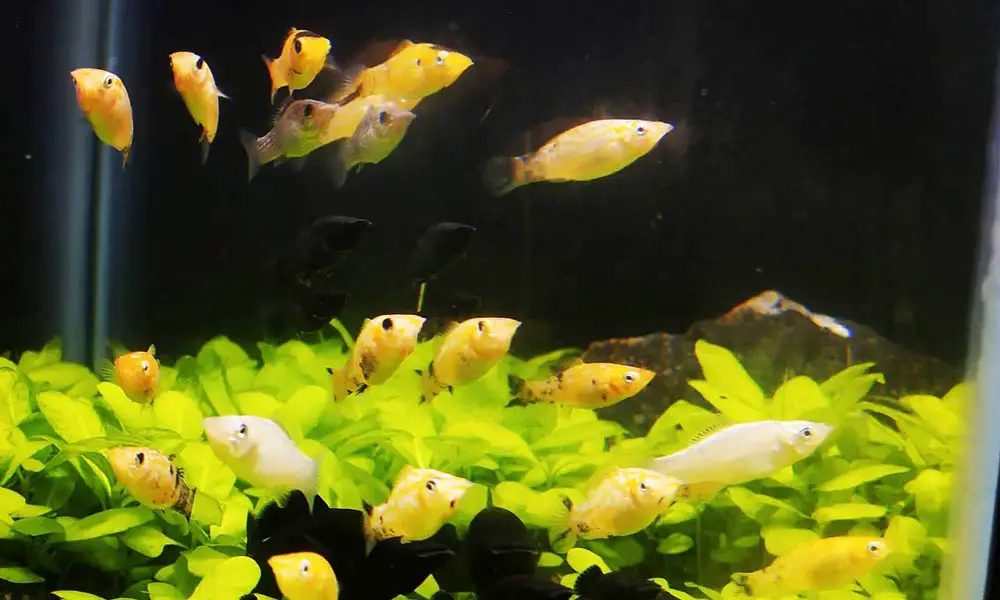
There is no surprise to see these shining mollies in your LFS since they are a staple of the freshwater community aquarium. Over 39 different species of mollies have been identified by scientists, let alone these captive-bred color variations.
The golden coloration of these fish is a result of selective breeding, and they come in a wide range of shades from yellow to orange-gold. They are relatively small, only growing up to about 3-4 inches (8-10 cm) in length.
Gold mollies are hardy, very adaptable, and can be kept in a wide range of water conditions, making them perfect for beginner fish keepers. They are also great additions to more experienced aquarists’ tanks because of their beautiful colors.
| Scientific Name: | Poecilia sp. |
| Common Name: | Molly fish |
| Care Level: | Beginner |
| Temperament: | Peaceful |
| Max Size: | 4 inches (10 cm) |
| Minimum Tank Size: | 30 gallons |
| Diet: | Omnivorous |
| Temperature: | 72°F to 78°F |
| PH: | 7.5 to 8.5 |
| Water hardness: | 20 – 30 KH |
Gold Barb Fish (Puntius semifasciolatus)

This species has many names in the aquarium trade but is known as the Chinese barb. The wild specimen is naturally green in color. Similar to the gold guppies and yellow platies, this gold-colored variant was selectively bred by Thomas Schubert in the 1960s and doesn’t exist in the wild.
It’s commonly sold as Gold Barb in the trade owing to its shiny, golden coloration. The gold barb is a small, peaceful fish that only grows to around 4 inches (10 cm) long.
They are schooling fish, so they need to be kept in groups of at least 6 or more to feel comfortable and thrive in the aquarium.
They also have a peaceful temperament making them a good choice for a community tank with other small, non-aggressive fish, including danios, tetras, and other barbs.
| Scientific Name: | Puntius semifasciolatus |
| Common Name: | Gold Barb Fish |
| Care Level: | Beginner |
| Temperament: | Peaceful |
| Max Size: | 4 inches (10 cm) |
| Minimum Tank Size: | 20 gallons |
| Diet: | Omnivorous |
| Temperature: | 64°F to 75°F |
| PH: | 6.0 to 8 |
| Water hardness: | 0 – 10 KH |
Lamp eye Congo Tetra (Phenacogrammus aurantiacus)

The lamp eye Congo tetra is a yellow-colored shimmering fish that’s native to the Congo River basin. It’s closely related to the African tetra and has a similar long, flat body shape with large scales and long flowing fins.
This species can grow up to 4 inches (10 cm) long but is usually closer to 3.5 inches (7.5 cm). They’re a peaceful schooling fish, so it’s best to keep them in groups of at least a half-dozen or more.
Lamp eye Congo tetras are fairly hardy, but only if kept in an environment that mimics their natural habitat – murky, slightly acidic water with darker substrates and floating plants.
| Scientific Name: | Phenacogrammus aurantiacus |
| Common Name: | Lamp eye Congo Tetra |
| Care Level: | Moderate |
| Temperament: | Peaceful |
| Max Size: | 3.5 inches (9 cm) |
| Minimum Tank Size: | 30 gallons |
| Diet: | Omnivorous |
| Temperature: | 73°F to 82°F |
| PH: | 6.0 to 7.5 |
| Water hardness: | 3 – 18 KH |
Golden Wonder Killifish (Aplocheilus lineatus)

The Golden Wonder Killifish is a stunning captive-bred variant of the striped panchax (Aplocheilus lineatus). Looking at the metallic yellow never gets old- it looks like a shiny yellow jewel swimming in your aquarium.
This is one of the larger Killifish species, growing up to around 4 inches (10 cm) long. Despite their size, they’re a relatively short-lived fish with a lifespan of only 2-3 years in captivity.
Killifish have the reputation of being difficult to care for, but the Golden Wonder is one of the more hardy and easier to keep variants. They’re peaceful schooling fish. You’ll need to commit to keeping a group of at least four fish.
These fish typically spend most of their time near the top of the aquarium, although they can often be seen swimming and feeding at all levels.
In addition, they are predators and will ruthlessly hunt down and eat any small fish or invertebrates they can fit in their mouths. So, it’s important to only keep them with peaceful tank mates that are too large to be considered food.
| Scientific Name: | Aplocheilus lineatus |
| Common Name: | Golden Wonder Killifish |
| Care Level: | Beginner |
| Temperament: | Peaceful |
| Max Size: | 4 inches (10 cm) |
| Minimum Tank Size: | 20 gallons |
| Diet: | Carnivore |
| Temperature: | 72°F to 75°F |
| PH: | 6.0 to 7.5 |
| Water hardness: | 3 – 8 KH |
Gold Chinese Algae Eater (Gyrinocheilus aymonieri)
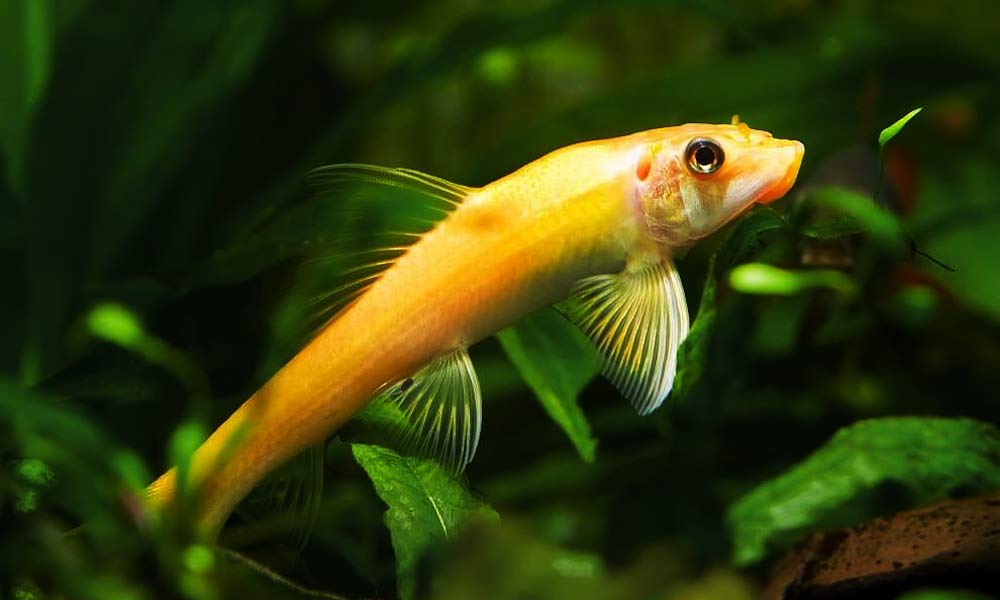
Looking for an ornate algae eater that’s a little different from the siamese algae eater? Then, you might want to consider the Gold Chinese Algae Eater. As their name suggests, this color variety sport a gorgeous golden yellow coloration that will definitely bring some extra flair to your aquarium.
Despite their name, Gold Chinese Algae Eaters are native to Northern India. These fish are well known for the purpose of keeping aquariums clean since they primarily feed on algae as juveniles. However, their dietary requirements change when they reach adulthood. Adults prefer more protein-rich foods and should be given a diet of bloodworms, brine shrimp, and other meaty foods.
Gold Chinese Algae Eaters can grow up to 12 inches (30 cm) long but are typically around 6-8 inches (15-20 cm). Because of their potential size, you’ll need to provide them with a spacious tank of at least 30 gallons.
The Gold Chinese Algae Eater is a solitary and semi-aggressive fish that will pick on tank mates. Peaceful fish that occupy the middle to the top water column can make possible tank mates.
| Scientific Name: | Gyrinocheilus aymonieri |
| Common Name: | Gold Chinese Algae Eater |
| Care Level: | Beginner |
| Temperament: | Peaceful |
| Max Size: | 12 inches (30 cm) |
| Minimum Tank Size: | 30 gallons |
| Diet: | Omnivorous |
| Temperature: | 74°F to 80°F |
| PH: | 5.8 to 8 |
| Water hardness: | 8 – 10 KH |
Lemon Bristlenose Pleco (Ancistrus sp.)
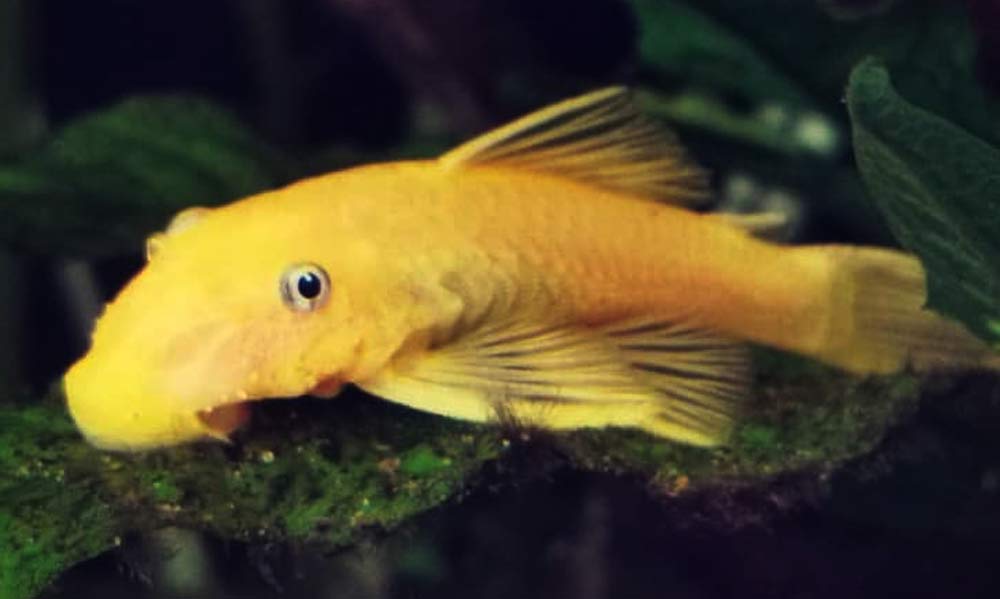
We have another terrific tank cleaner for keeping algae at bay – the Bristlenose Pleco! When talking about the appearance of Bristlenose Plecos, there are several colors and patterns to choose from. But, the Blue Eye Lemon Bristlenose is one of the most beautiful.
This man-made color morph can easily recognize because of the light yellow body with blue eyes. Adults have some red hues on their bodies, while juveniles are mostly yellow.
The Blue Eye Lemon Bristlenose Pleco is a small species that only grow up to 4 to 5 inches (10 to 13 cm). Compared with the other common catfish, this smaller size is one of the reasons why Bristlenose Plecos are such a popular choice for aquariums.
Males can be highly territorial with each other when mature. It’s best to provide them with plenty of hiding spots and ample territory for each fish to reduce the aggression.
Like other Pleco species, Bristlenose Plecos are nocturnal bottom-dwellers that spend most of their time hiding during daytime hours and prefer to come out to feed at night.
Make sure to provide plenty of driftwoods in your tank. It’s not only a great hiding spot for your Pleco but also helps to create a good substrate where the algae can grow for them to graze on.
| Scientific Name: | Ancistrus sp. |
| Common Name: | Lemon Bristlenose Pleco |
| Care Level: | Beginner |
| Temperament: | Peaceful |
| Max Size: | 5 inches (13 cm) |
| Minimum Tank Size: | 30 gallons |
| Diet: | Omnivorous |
| Temperature: | 72°F to 86°F |
| PH: | 6.5 to 7.5 |
| Water hardness: | 6 – 10 KH |
Honey blue-eye (Pseudomugil mellis)
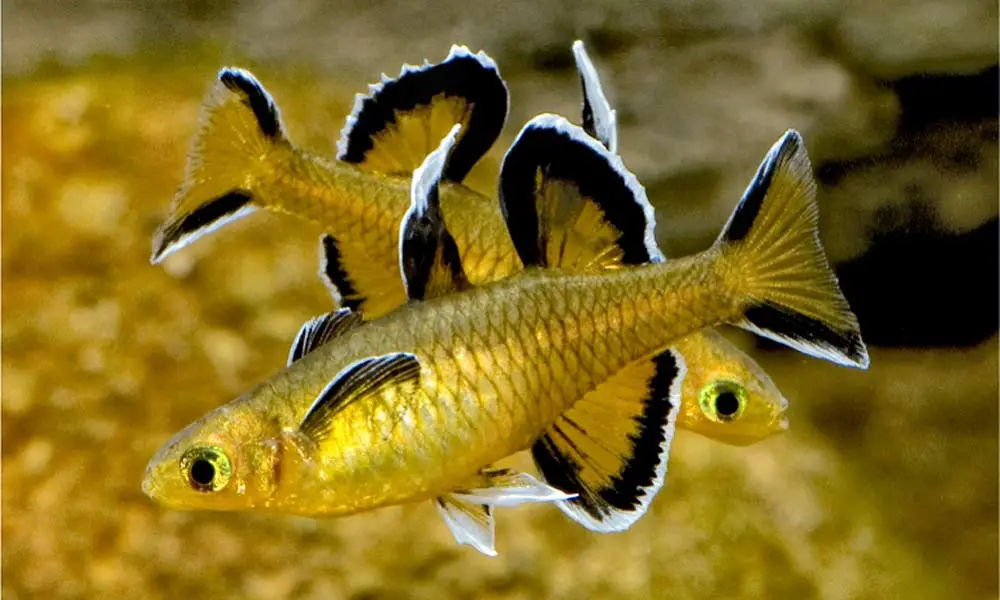
The honey blue-eye is an endangered species of fish that is found in Australia, where it inhabits mildly acidic ponds and streams.
It’s a small freshwater species that only reaches a length of between 0.98 to 1.2 inches (2.5 – 3 cm), usually not exceeding 1.6 inches (4cm).
The honey blue-eye is a yellowish-brown fish with a single horizontal line starting from the tip of the pectoral fin and running along its body. Its eyes are a distinctive blue color, which has led to its name. This species is also sometimes known as the blue-eye rainbowfish.
The males are one of the unique fish in the world due to the distinct black submarginal bands and white strokes that are present on their dorsal, anal, and caudal fin. Females, on the other hand, have clear fins.
Honey blue-eyes are schooling fish. In the wild, they form schools of around 25-70 fish, but in captivity, a group of 5-6 will do. These fish have a short lifespan of only 1-2 years in the wild. Even in aquariums, they only live up to 2 years.
| Scientific Name: | Pseudomugil mellis |
| Common Name: | Honey blue-eye |
| Care Level: | Beginner |
| Temperament: | Peaceful |
| Max Size: | 1.2 inches (3 cm) |
| Minimum Tank Size: | 15 gallons |
| Diet: | Omnivorous |
| Temperature: | 72°F to 86°F |
| PH: | 4.4 to 6.0 |
| Water hardness: | 6 – 10 KH |
Yellow Rainbowfish (Melanotaenia herbertaxelrodi)
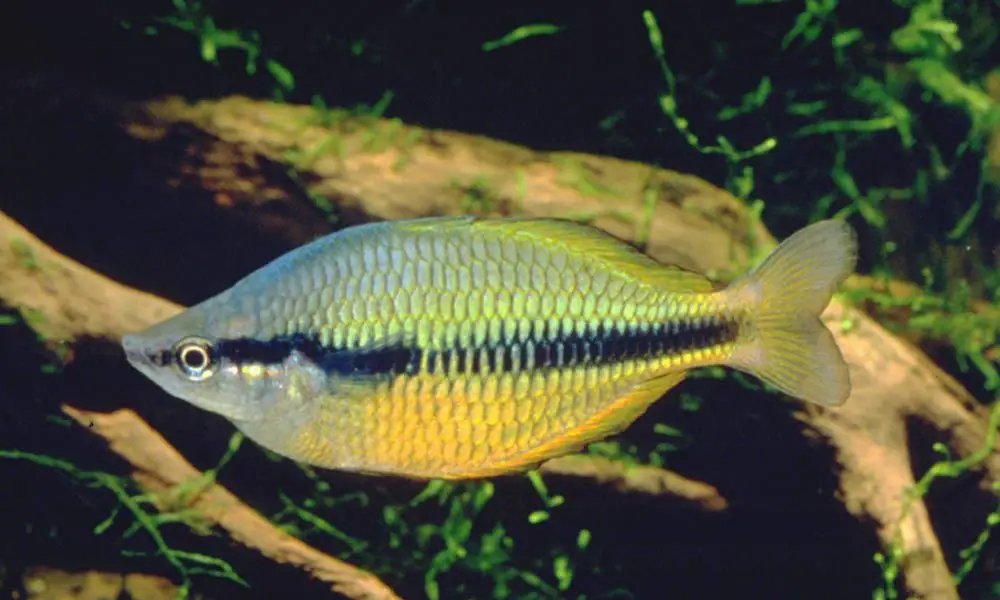
This is one of our all-time favorite rainbowfish species because of its bright colors, ranging from yellow to orange, and active personality.
This species is relatively small, only reaching lengths of 4 inches (10 cm). In the wild, yellow rainbowfish is endemic to the Lake Tebera basin, which gets its common name, Lake Tebera rainbowfish.
The dominant male has a yellow body with a black line that runs down its midline. The dorsal, anal, and caudal fins are often a darker yellow or orange, and the male usually has a more intense coloration than the females. When they are ready to spawn, the yellow on their bodies and reddish on their fins will intensify.
The Yellow Rainbowfish is a peaceful community fish that can be kept in groups of 6 or more fish with other similar-sized rainbowfish and peaceful dwarf cichlids.
| Scientific Name: | Melanotaenia herbertaxelrodi |
| Common Name: | Yellow Rainbowfish |
| Care Level: | Beginner |
| Temperament: | Peaceful |
| Max Size: | 4 inches (10 cm) |
| Minimum Tank Size: | 30 gallons |
| Diet: | Omnivorous |
| Temperature: | 70°F to 80°F |
| PH: | 7.0 to 8.0 |
| Water hardness: | 10 – 15 KH |
Yellow Discus Fish (Symphysodon sp.)
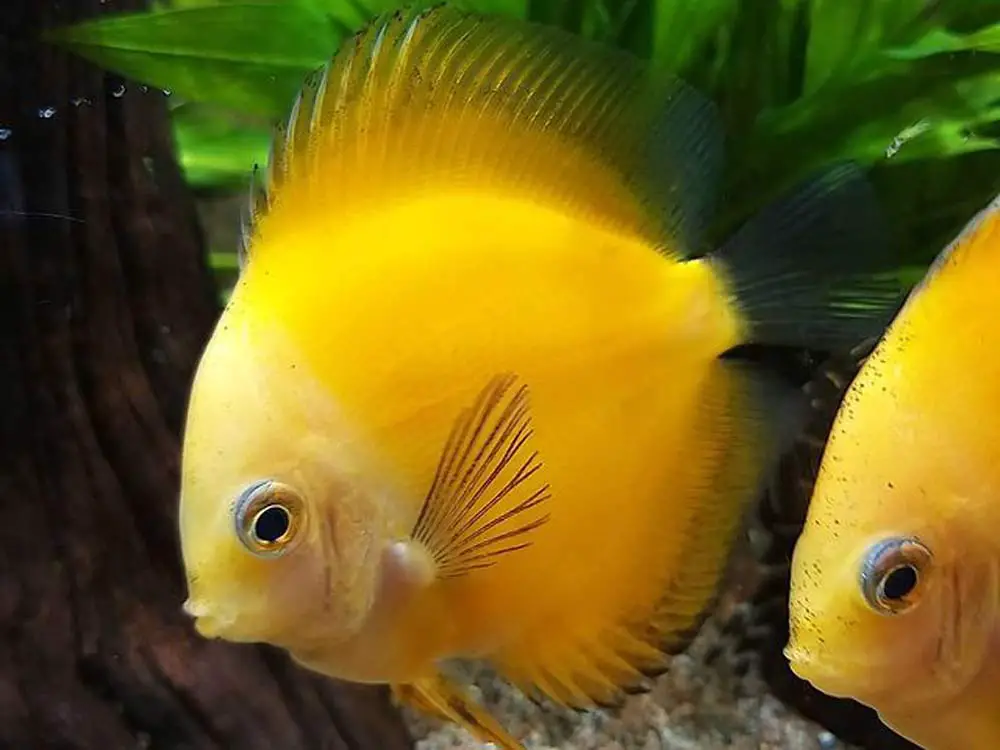
Discus are often referred to as “King of the Aquarium,” known for their regal appearance and beautiful colors. There are many different types of Discus that come in a wide variety of colors.
The yellow discus fish is a selected-breeding color morph of the most popular Marlboro Red Discus. You’ll see a bright yellow coloration covered all across their body. Their dorsal and anal fins are a bit pale yellow and white, accompanied by a black top edge.
These fish have a notorious reputation as one of the most difficult fish to keep in an aquarium. They are very sensitive to changes in water quality and parameters and require very strict dietary needs to thrive.
That being said, yellow discus are some of the most beautiful fish you can find, but we recommend them for experienced aquarists only.
| Scientific Name: | Symphysodon sp. |
| Common Name: | Yellow Discus Fish |
| Care Level: | Moderate |
| Temperament: | Peaceful |
| Max Size: | 8 inches (20 cm) |
| Minimum Tank Size: | 55 gallons |
| Diet: | Carnivore |
| Temperature: | 79°F to 86°F |
| PH: | 6.1 to 7.5 |
| Water hardness: | 3 – 8 KH |
Gold Severum (Heros severus)

The Gold Severum, or Banded Cichlid, is a captive-bred color variation of wild green severum. Similar to their larger cousins, the Discus cichlids, they have a deep oval-shaped body with iridescent scales.
This mid-sized cichlid can reach lengths of up to 8 inches (20 cm). Females are usually a bit smaller than males.
Gold Severums are peaceful fish but can be aggressive towards other fish when spawning. They can be kept singly or as a mated pair with other similarly sized fish when ample space is provided.
| Scientific Name: | Heros Severus |
| Common Name: | Gold Severum, Banded Cichlid |
| Care Level: | Moderate |
| Temperament: | Semi-aggressive |
| Max Size: | 8 inches (20 cm) |
| Minimum Tank Size: | 55 gallons |
| Diet: | Carnivore |
| Temperature: | 73°F to 77°F |
| PH: | 6.0 to 7.2 |
| Water hardness: | 4 – 5 KH |
Gold Ram Cichlid (Mikrogeophagus ramirezi)
Gold Ram Cichlids deserve a place on our list of beautiful yellow tropical fish. These man-made little beauties have been popular among Cichlid keepers for decades because of their overall yellow coloration and peaceful demeanor.
Their bodies start off bright gold/yellow, adorned with scattered neon blue and red spots. The yellow color is more intense in males, especially during spawning, while females usually have a bit more yellow on their dorsal and anal fins.
Gold Rams are a small cichlid and can reach up to 2 inches (5 cm) in length. They are peaceful fish that can be kept in pairs or small groups with other delicate fish as long as there is adequate space.
| Scientific Name: | Mikrogeophagus ramirezi |
| Common Name: | German Gold Ram, Gold Ram Cichlid |
| Care Level: | Advanced |
| Temperament: | Peaceful |
| Max Size: | 2 inches (5 cm) |
| Minimum Tank Size: | 30 gallons |
| Diet: | Omnivore |
| Temperature: | 72°F to 79°F |
| PH: | 5.0 to 7.0 |
| Water hardness: | 5 – 12 KH |
Gold Convict Cichlid (Cryptoheros nanoluteus)
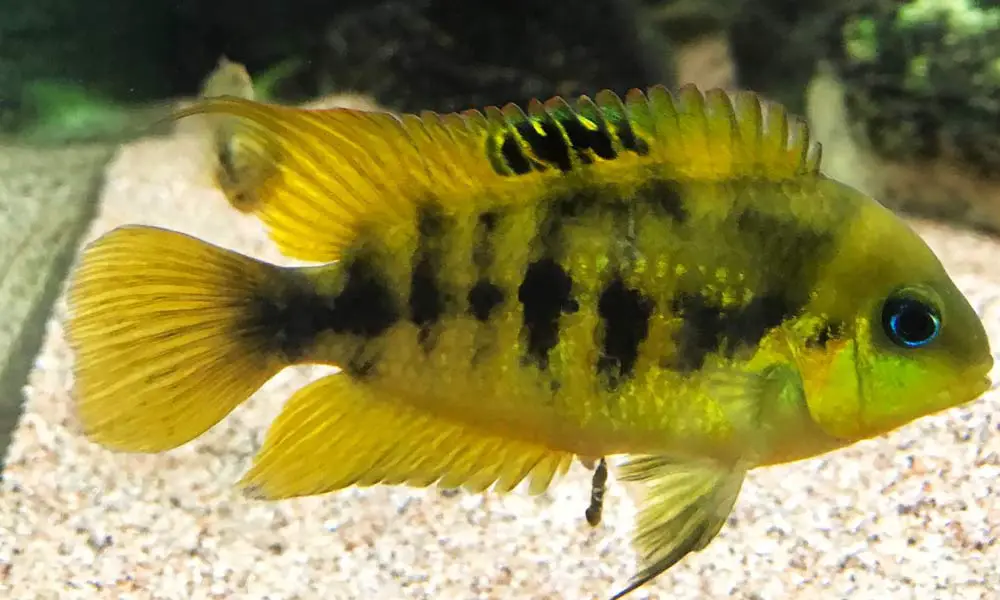
When you think of yellow cichlid, convicts don’t normally come to mind. Common Convict cichlids get their name from their dark black and white stripes resembling prisoners’ uniforms.
However, yellow convict cichlids are a captive-bred color morph of the Common Convict. They have all the same markings as their wild cousins, but instead of black and white, they are yellow and black.
These fish can reach up to 4 inches (10 cm) in length. Males are slightly larger than females and develop a slight hump, while females exhibit a distinctive black circle on their dorsal fin.
Yellow convicts are not aggressive as their close relatives but can be territorial when breeding. The best tank mates should be these small Central American cichlids.
| Scientific Name: | Cryptoheros nanoluteus |
| Common Name: | Gold Convict Cichlid |
| Care Level: | Moderate |
| Temperament: | Semi-aggressive |
| Max Size: | 4 inches (10 cm) |
| Minimum Tank Size: | 30 gallons |
| Diet: | Omnivore |
| Temperature: | 72°F to 81°F |
| PH: | 7.2 to 8.0 |
| Water hardness: | 4 – 12 KH |
Panda Dwarf Cichlid (Apistogramma nijsseni)
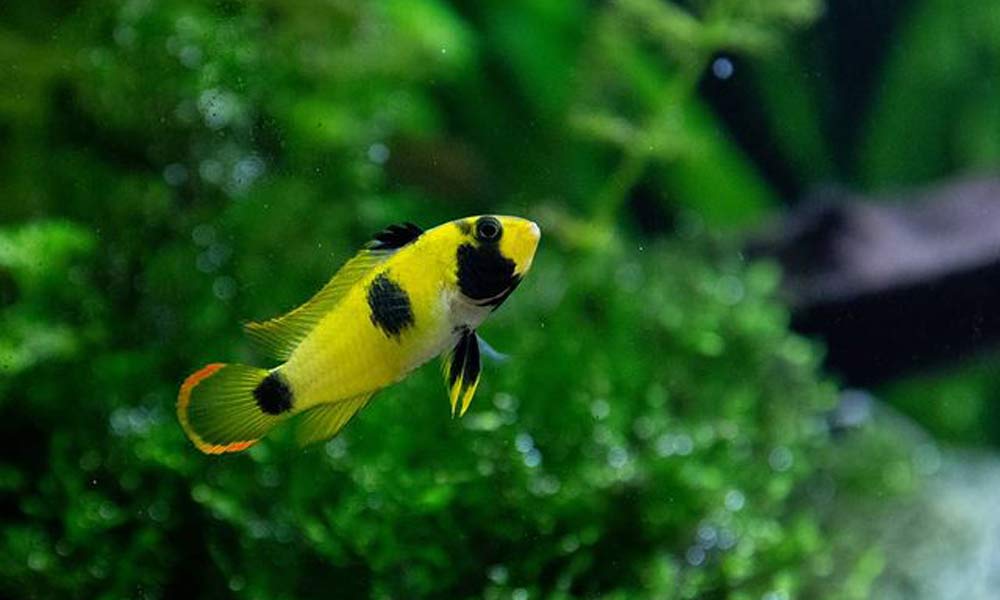
Any list of colorful cichlid is incomplete without at least one species of Apistogramma. These fishes are some of the most wonderful, brightly colored cichlids in many community tanks!
The popularity of the Panda Dwarf Cichlids is attributed to their unique ‘panda bear’ color and pattern. In addition, these fish are known as one of the easiest species for aquarists to breed.
Author note: Convict cichlids hold the #1 spot of the easiest cichlid to breed. They are referred to as the ‘rabbits of the fish world.’
Compared with most other Apistos, this species tends to be a bit more fat and wide. But it’s still a small fish, with males only reaching up to 3 inches (7.5 cm) and females a bit smaller at 1.75 inches (4.5 cm).
Panda Dwarfs are peaceful cichlids that can be kept in pairs or small groups with other similarly sized fish, who tend to occur at the top of the tank.
| Scientific Name: | Apistogramma nijsseni |
| Common Name: | Panda Dwarf Cichlid |
| Care Level: | Advanced |
| Temperament: | Peaceful |
| Max Size: | 3 inches (7.5 cm) |
| Minimum Tank Size: | 20 gallons |
| Diet: | Carnivore |
| Temperature: | 73°F to 86°F |
| PH: | 5.0 to 7.0 |
| Water hardness: | 2 – 10 KH |
Electric Yellow Lab (Labidochromis Caeruleus)
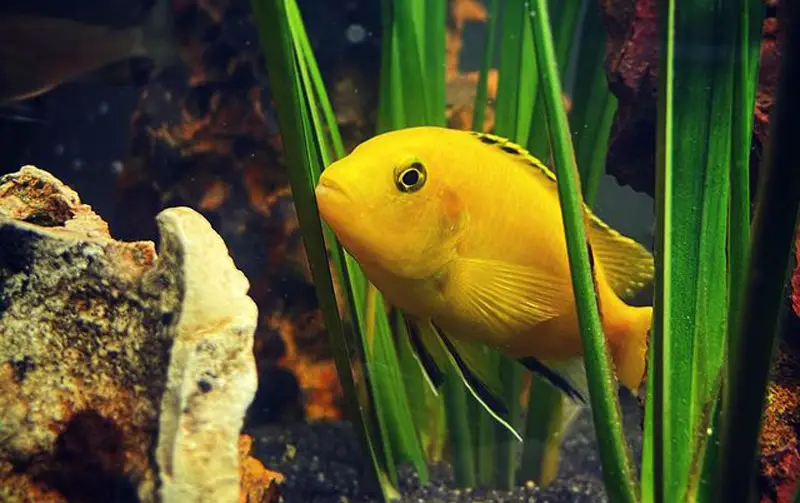
Electric Yellow Lab, also known as Electric Yellow Cichlid, is undoubtedly one of the beginner-friendly Mbunas out there. Their strikingly naturally occurring yellow morph makes them a popular fish for Cichlid enthusiasts.
This yellow cichlid is a small African cichlid that only reaches about 4 inches (10 cm) when fully grown. Several color variations are occasionally available, depending on where they were observed in the lake.
Electric Yellow Labs are “peaceful” mbuna that are best kept in a species-only tank or mixed with other attractive mbuna species in a heavy-stocked Malawi aquarium.
| Scientific Name: | Labidochromis caeruleus |
| Common Name: | Yellow Lab Cichlid, Electric Yellow Lab, Lemon Yellow Lab, Yellow Labido, and Lemon drop Cichlid |
| Care Level: | Beginner |
| Temperament: | Semi-aggressive |
| Max Size: | 4 inches (10 cm) |
| Minimum Tank Size: | 55 gallons |
| Diet: | Omnivorous |
| Temperature: | 73°F to 82°F |
| PH: | 7.7 to 8.6 |
| Water hardness: | 10 – 25 KH |
Lemon Jake Peacock (Aulonocara sp.)
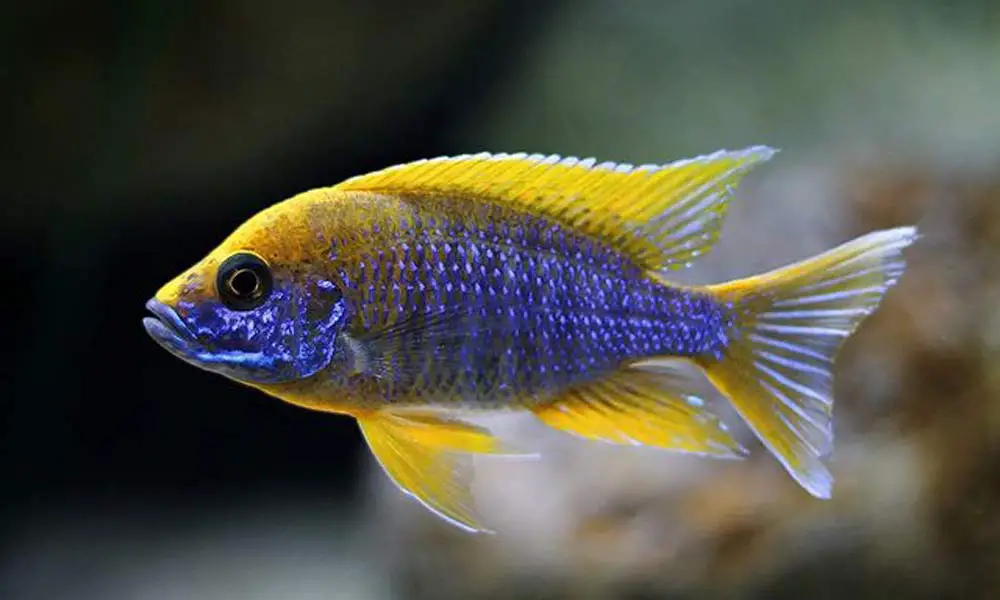
Here’s another beautiful fish from Lake Malawi that makes our yellow cichlid list. The striking Lemon Jake is a yellow/gold color morph of the Aulonocara jacobfreibergi.
There are many color variations, but mostly show a lot of bright yellow on its fins, forehead, and shoulder. The yellow color accentuates the blue on the face and body.
Adults can reach up to 6 inches (15 cm). Despite their size, these hybrids are rather aggressive than A. jacobfreibergi. You should not mix them with male Aulonocara species as they get too big and nasty.
| Scientific Name: | Aulonocara sp. |
| Common Name: | Lemon Jake Peacock |
| Care Level: | Moderate |
| Temperament: | Semi-aggressive |
| Max Size: | 6 inches (15 cm) |
| Minimum Tank Size: | 75 gallons |
| Diet: | Carnivore |
| Temperature: | 78°F to 82°F |
| PH: | 7.8 to 8.6 |
| Water hardness: | 10 – 18 KH |
Lemon Cichlid (Neolamprologus leleupi)

Last but definitely not least on our yellow tropical fish list is the Lemon Cichlid. The Lemon Cichlid is a relatively small cichlid that is endemic to Lake Tanganyika’s deep waters.
As the name suggests, this cichlid is bright yellow in coloration, while several color morphs, ranging from deep brown to orange to reddish, are discovered in the lake.
Lemon Cichlids have been selectively bred in captivity for years, and many captive-bred variations can be found in the trade with descriptive names, including Super Bright Orange, Dutch Orange, and Firecracker.
These fish are relatively peaceful but can be aggressive to their own kind. They do best when kept singly or as a single pair in a Tanganyika community tank with other peaceful cichlids of similar size and temperament.
| Scientific Name: | Neolamprologus leleupi |
| Common Name: | Lemon Cichlid, Orange Cichlid, Gold Cichlid, and Gold Leleupi Cichlid |
| Care Level: | Advanced |
| Temperament: | Aggressive |
| Max Size: | 3.9 inches (10 cm) |
| Minimum Tank Size: | 20 gallons |
| Diet: | Carnivore |
| Temperature: | 73°F to 81°F |
| PH: | 7.6 to 9.0 |
| Water hardness: | 12 – 15 KH |
Which Do You Like Most?
We hope you enjoyed this list of yellow tropical fish! Whether you just started your first fish tank or are looking for new additions, there should be a yellow fish on this list for you.
Do you have a favorite yellow freshwater fish that didn’t make our list? We would love to hear from you in the comment section below!
